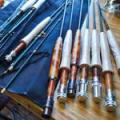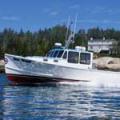The Shark That Ate Our Summer
 The unexpected visitor caused quite a stir while hitching a ride. Photo courtesy Alison O’Leary
The unexpected visitor caused quite a stir while hitching a ride. Photo courtesy Alison O’Leary
We were sailing east from the west passage of Narragansett Bay, Rhode Island, a couple miles offshore on a perfect mid-July day when, BAM! a crash got our attention.
“Something jumped into the dinghy!” yelled my partner John.
Sure enough, a triangular blue fin was visible in the gray Mercury inflatable that we were towing about 12 feet behind my 25-foot Catalina sailboat, the Esmeralda.
It was funny at first. We caught dinner! Then we got a closer look and realized the hitchhiker was a toothy 4- to 5-foot shark, not a bluefish that we could easily dispatch and filet.
To be honest, my reaction was to do nothing. I’m a writer. I’m not putting my hands near the thrashing interloper with three rows of razor-sharp teeth! It jumped in, so maybe it would jump out, I thought.
John pulled the dinghy alongside. “We have to get the stuff out before it floats away,” he said, handing me an oar with a big bite taken out of the blade and a shredded orange life jacket.
The dinghy filled with water as its air chambers collapsed. The shark calmed down a bit, appearing to relax athwartships, against one pontoon. It turned a black glassy eye in our direction as its teeth remained embedded in the dinghy’s hide.
In preparation for our month-long voyage to Maine we discussed navigation, safety, sustenance, and lots of other topics, but we didn’t have a plan for dealing with a shark. After the shock wore off and the dinghy started to sink with the shark still in it, we doused the sails and let the tiller go to focus on the big fish. John pulled the dinghy close again and leaned way over the gunwale of the sailboat. Being over six feet tall he has the wingspan of a pro basketball player, making it possible to grab the shark by the tail. He said he knew that sharks can’t bend 180 degrees to bite so it didn’t worry him (he’s an accomplished fisherman). I wasn’t so sure.
But the shark had different plans. It had rolled around while chomping on a line inside the boat. The result was that its head was completely wrapped in the rope, making it difficult for John to dislodge. The scene reminded me of a puppy playing tug-of-war with a chew toy. John eventually got the fish untangled, and lifted the limp boat at the bow, encouraging the shark to re-enter the sea. It finally let go and swam away, its beautiful blue skin fading into the water.
We raised the sails and tried to continue towing my ravaged dinghy, which responded like a sea anchor, slowing us way down. I lamented the loss of my inflatable, which while easily 15 years old had been affordable—and it used to hold air. Coupled with a secondhand 4-hp engine of about the same vintage (but which was refusing to start) it was an acceptable dinghy for my 35-year-old boat. Neither would win beauty contests, but they got us to lots of fun places.
After the shark departed, I thought about the resources I’ve leaned on: other sailors and boat owners who converse on social media group pages. Posting a photo of the shark in the dinghy, I asked other sailors how to approach repairs. Perhaps our only option would be replacement, but that would be difficult to achieve during an extended cruise. The photo got lots of attention, both positive and negative. Suggestions poured in, particularly from the Facebook Maine Sailing and Cruising page, indicating that midcoast Maine probably has the most dense concentration of PVC repair professionals of any part of the country.
We attempted to patch the boat during a stop in Onset, but the biggest bites were difficult to patch successfully with limited workshop facilities.
In Gloucester we ran into another couple using the harbormaster’s mariner’s lounge. I mentioned the shark. “That was you!” exclaimed the woman. She yelled to her husband, Bob, who was in the shower. “They’re the people with the shark in their dinghy!” Boom, we were invited to dinner and given chauffeur service to boot.
A day later a young launch driver from Portsmouth Yacht Club had the same reaction when we told him about the dinghy rolled up on the bow of our boat. “That was you? I just saw that online.” According to the young man, one of my Facebook posts had been picked up by an influential fishing/boating page, but it didn’t yield any solutions to our tender-less cruise issue.
A shark specialist, David “WhySharksMatter” Shiffman, identified the creature as a mako, and told me that our experience wasn’t so special after all. “Sharks jump,” he said. “It didn’t jump into your boat intentionally.”
Alison O'Leary is a New England sailor, hiker, and author who presents programs on the topics of her books and her adventures. For more information visit www.alisonoleary.com.
Related Articles
Share this article:
2023 Maine Boat & Home Show

Join Us for the Maine Boat & Home Show!
Art, Artisans, Food, Fun & Boats, Boats, Boats
August 11 - 13, 2023 | On the waterfront, Rockland, Maine
Click here to pre-order your tickets.
Show is produced by Maine Boats, Homes & Harbors magazine.















